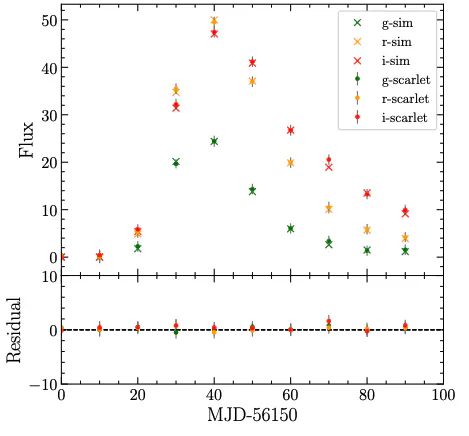Disentangling transients and their host galaxies with Scarlet2: A framework to forward model multi-epoch imaging
Sep 1, 2024·,,,,,,,,·
2 min read
C Ward
P Melchior
ML Sampson
C Burke
J Siegel
B Remy
S Birmingham
E Ramey
S Van Velzen

Abstract
Many science cases for wide-field time-domain surveys rely on accurate identification and characterization of the galaxies hosting transient and variable objects. In the era of the Legacy Survey of Space and Time (LSST) at the Vera C. Rubin Observatory the number of known transient and variable sources will grow by orders of magnitude, and many of these sources will be blended with their host galaxies and neighboring galaxies. A diverse range of applications - including the classification of nuclear and non-nuclear sources, identification of potential host galaxies, extraction of host galaxy SEDs without requiring a transient-free reference image, and combined analysis of photometry from multiple surveys - will benefit from a flexible framework to model time-domain imaging of transients. We describe a time-domain extension of the Scarlet2 scene modeling code for multi-epoch, multi-band, and multi-resolution imaging data to extract simultaneous transient and host galaxy models. Scarlet2 leverages the benefits of data-driven priors on galaxy morphology, is fully GPU compatible, and can jointly model multi-resolution data from ground and space-based surveys. We demonstrate the method on simulated LSST-like supernova imaging, low-resolution Zwicky Transient Facility imaging of tidal disruption events, and Hyper Suprime Cam imaging of variable AGN out to z = 4 in the COSMOS fields. We show that Scarlet2 models provide accurate transient and host galaxy models as well as accurate measurement of host-transient spatial offsets, and demonstrate future applications to the search for ‘wandering’ massive black holes.
Type
Publication
arXiv preprint arXiv:2409.15427
Many science cases for wide-field time-domain surveys rely on accurate identification and characterization of the galaxies hosting transient and variable objects. In the era of the Legacy Survey of Space and Time (LSST) at the Vera C. Rubin Observatory the number of known transient and variable sources will grow by orders of magnitude, and many of these sources will be blended with their host galaxies and neighboring galaxies. A diverse range of applications - including the classification of nuclear and non-nuclear sources, identification of potential host galaxies, extraction of host galaxy SEDs without requiring a transient-free reference image, and combined analysis of photometry from multiple surveys - will benefit from a flexible framework to model time-domain imaging of transients. We describe a time-domain extension of the Scarlet2 scene modeling code for multi-epoch, multi-band, and multi-resolution imaging data to extract simultaneous transient and host galaxy models. Scarlet2 leverages the benefits of data-driven priors on galaxy morphology, is fully GPU compatible, and can jointly model multi-resolution data from ground and space-based surveys. We demonstrate the method on simulated LSST-like supernova imaging, low-resolution Zwicky Transient Facility imaging of tidal disruption events, and Hyper Suprime Cam imaging of variable AGN out to z = 4 in the COSMOS fields. We show that Scarlet2 models provide accurate transient and host galaxy models as well as accurate measurement of host-transient spatial offsets, and demonstrate future applications to the search for ‘wandering’ massive black holes.